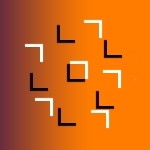
ISSN 2364-3641
Publications:
direct access:
vpl-reports.de
Open Access
| home | evaluation | archive | vpl-goettingen.de | impressum |
|
VPL-reports, 8, 1-32
Using line arrays and the technique of cued visual selection (Nothdurft, 2017a;
www.VPL-reports.de/6/) I measured the ability of
observers to identify cued targets in binocular presentations. Experiment 1 was designed to measure target
visibility and was partly performed on monocular and binocularly non-rivaling line patterns. Target detection
was perfect even when cues and targets were presented in different eyes. With binocularly rivaling stimuli,
subjects saw cued targets in the dominant eye better than targets in the non-dominant eye. In Experiments 2-4,
the dynamics of binocular interactions were measured by cuing lines in rivaling patterns at various delays
(up to 5 s after stimulus onset). In Experiment 2, the locally orthogonal lines had similar strength; in
Experiment 3, they differed in contrast; and in Experiment 4, one pattern was presented 3 s in advance for
adaptation. In all experiments, there were strong modulations of monocularly cued target detection rates during
the initial 500-1000 ms after stimulus onset, when perceptual reversals are rare or absent; after that period
detection rates settled and remained nearly constant although perceptual rivalry is supposed to be strong during
that time. This suggests that alternating percepts in binocular rivalry are likely not based on variations in
ocular sensitivity alone. Target ratings with binocular cues, in these periods, were largely predicted by
averaging the ratings with monocular cues. In Experiment 5, cued target detection was related to the observers'
momentary percepts. Subjects were asked to attend to a particular line, and cues were given at various delays
after a perceived line reversal. In this condition, target detection was modulated between attended and
non-attended target features and locations, providing evidence for both feature-based and spatial attention
effects. In all five experiments, there was a notable asymmetry of target detection rates between the dominant
and the non-dominant eyes of observers.
|
Download pdf ppt of figures Comments: |
©